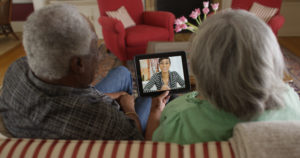COVID-19: the importance of keeping up your social connections
March 20, 2020 • Uncategorized
 As more kids find themselves homebound now that families across the country are practicing safe distancing to prevent the spread of coronavirus, it may be important to increase, rather than limit, screen time for children and teens, say two researchers at the University of North Texas Health Science Center at Fort Worth School of Public Health.
As more kids find themselves homebound now that families across the country are practicing safe distancing to prevent the spread of coronavirus, it may be important to increase, rather than limit, screen time for children and teens, say two researchers at the University of North Texas Health Science Center at Fort Worth School of Public Health.
Professors Dana M. Litt, PhD, and Melissa A. Lewis, PhD, have long been involved in research projects related to the impact and influences of social media on young adults.
In this current uncertain and challenging time, they say, people of all ages, and especially the young, can benefit greatly from staying connected with others virtually while they are on break from doing so in person.
“There are risks to isolation,” Dr. Litt said. “Anxiety, unease and missing your connections with friends, family and others can take a toll on well-being. For many young adults, communicating online is a major part of their social life, and especially so when they can’t be face-to-face with friends.”
As a mother of two young children ages 7 and 10, Dr. Lewis is allowing her kids more opportunity for FaceTime, online chats, safe and supervised online games, and other virtual activities.
“The current situation is affecting younger kids too,” Dr. Lewis said. “In place of play dates, more families are adopting an online approach. Your children will follow your lead. Let them know the seriousness of what we’re facing right now and offer them alternatives for staying close with their friends in new and different ways.”
To make St. Patrick’s Day more fun for younger kids in her neighborhood, Dr. Lewis and other parents organized a shamrock hunt, where families created and posted handcrafted designs that could be found in one person’s window, taped to someone else’s garage door or displayed in another easily visible spot. To date, the count is up to 37 shamrocks found and more to search for when families take safe, social-distanced walks together.
Her kids have also called out “happy birthday” to neighbor friends while walking by, and have ideas for dropping notes in different mailboxes to brighten people’s day.
“While physical distancing is what’s being called for right now,” Dr. Litt said, “we shouldn’t underestimate the basic human need for social support and interaction. Not only does it enrich our lives, it also keeps us happy and well.”
The same goes for elderly and extended family members, as well as close adult friends.
 “People want to keep older relatives and the most vulnerable populations safe right now, but they also miss each other. My family is setting up some 30-minute video chat times, so we can see each other and not feel so far apart as we work through this,” Dr. Litt said.
“People want to keep older relatives and the most vulnerable populations safe right now, but they also miss each other. My family is setting up some 30-minute video chat times, so we can see each other and not feel so far apart as we work through this,” Dr. Litt said.
She is also planning a virtual brunch with friends to replace their usual weekend get-togethers, and recommends that dinners and other regular activities could be scheduled that way for the time being, to help friends and other groups keep in touch.
With the possibility of continued church, restaurant and other closings, families may also want to rethink this year’s Easter plans to take activities virtual, both professors advise.
“It’s also a good time to move book clubs online, for both kids and adults,” Dr. Lewis said. “Not only are they fun and engaging, but they can also be a great way to help kids keep up with schoolwork while they are at home.”
The two HSC professors, who have worked together for 10 years since first meeting when Dr. Litt was selected for a postdoctoral fellowship under Dr. Lewis’ mentorship, consider themselves not just professional colleagues in their research and teaching but also friends, and the recent change to social distancing has been challenging for them as well.
“We’re work friends, but we are also like sisters,” Dr. Litt said. “We’ve gone on vacations together, we know each other’s families, we are together a lot, so this has been a big change for us too. But as we’re working remotely now, we are also working hard to maintain our personal connection and a social schedule that keeps us close.”
“In addition to all the virtual tools we have available, there’s also the phone,” Dr. Lewis said. “We still talk to each other several times a day.”

Social media